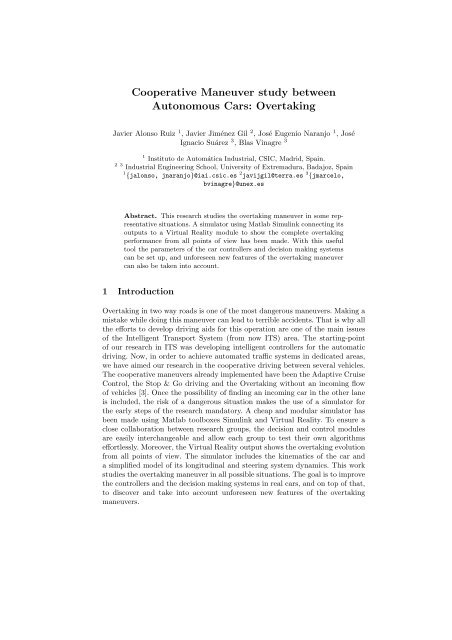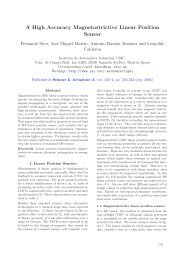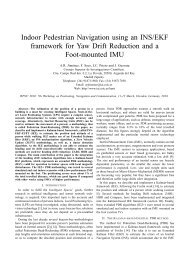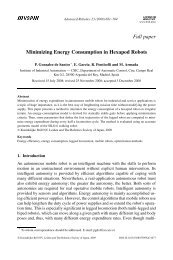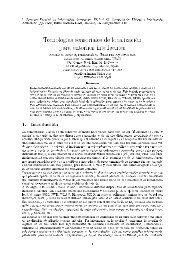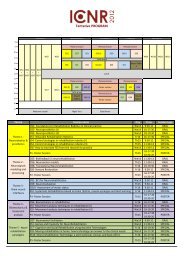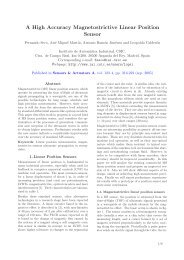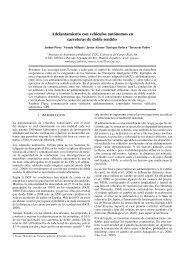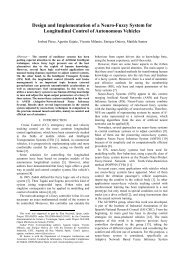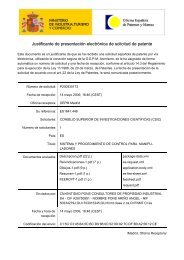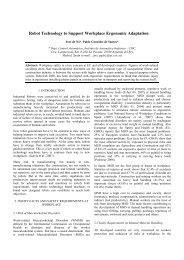Cooperative Maneuver study between Autonomous Cars: Overtaking
Cooperative Maneuver study between Autonomous Cars: Overtaking
Cooperative Maneuver study between Autonomous Cars: Overtaking
You also want an ePaper? Increase the reach of your titles
YUMPU automatically turns print PDFs into web optimized ePapers that Google loves.
<strong>Cooperative</strong> <strong>Maneuver</strong> <strong>study</strong> <strong>between</strong><br />
<strong>Autonomous</strong> <strong>Cars</strong>: <strong>Overtaking</strong><br />
Javier Alonso Ruiz 1 , Javier Jiménez Gil 2 , José Eugenio Naranjo 1 , José<br />
Ignacio Suárez 3 , Blas Vinagre 3<br />
1 Instituto de Automática Industrial, CSIC, Madrid, Spain.<br />
2 3 Industrial Engineering School, University of Extremadura, Badajoz, Spain<br />
1 {jalonso, jnaranjo}@iai.csic.es 2 javijgil@terra.es 3 {jmarcelo,<br />
bvinagre}@unex.es<br />
Abstract. This research studies the overtaking maneuver in some representative<br />
situations. A simulator using Matlab Simulink connecting its<br />
outputs to a Virtual Reality module to show the complete overtaking<br />
performance from all points of view has been made. With this useful<br />
tool the parameters of the car controllers and decision making systems<br />
can be set up, and unforeseen new features of the overtaking maneuver<br />
can also be taken into account.<br />
1 Introduction<br />
<strong>Overtaking</strong> in two way roads is one of the most dangerous maneuvers. Making a<br />
mistake while doing this maneuver can lead to terrible accidents. That is why all<br />
the efforts to develop driving aids for this operation are one of the main issues<br />
of the Intelligent Transport System (from now ITS) area. The starting-point<br />
of our research in ITS was developing intelligent controllers for the automatic<br />
driving. Now, in order to achieve automated traffic systems in dedicated areas,<br />
we have aimed our research in the cooperative driving <strong>between</strong> several vehicles.<br />
The cooperative maneuvers already implemented have been the Adaptive Cruise<br />
Control, the Stop & Go driving and the <strong>Overtaking</strong> without an incoming flow<br />
of vehicles [3]. Once the possibility of finding an incoming car in the other lane<br />
is included, the risk of a dangerous situation makes the use of a simulator for<br />
the early steps of the research mandatory. A cheap and modular simulator has<br />
been made using Matlab toolboxes Simulink and Virtual Reality. To ensure a<br />
close collaboration <strong>between</strong> research groups, the decision and control modules<br />
are easily interchangeable and allow each group to test their own algorithms<br />
effortlessly. Moreover, the Virtual Reality output shows the overtaking evolution<br />
from all points of view. The simulator includes the kinematics of the car and<br />
a simplified model of its longitudinal and steering system dynamics. This work<br />
studies the overtaking maneuver in all possible situations. The goal is to improve<br />
the controllers and the decision making systems in real cars, and on top of that,<br />
to discover and take into account unforeseen new features of the overtaking<br />
maneuvers.
2 Simulator Overlook<br />
The simulator is built on Matlab Simulink and includes the modeled cars with<br />
the kinematics and some dynamics. There is a module, the decision making subsystem,<br />
which opts for the best behavior in each moment. The fuzzy controller<br />
turns a desired behavior into the appropriate orders for the steering wheel, accelerator<br />
and brake. And the Virtual Reality output allows us to see the evolution<br />
of the maneuver from all points of view. The information used for the modeled<br />
Fig. 1. Main diagram of the overtaking simulator.<br />
cars in the simulator intended to be the same as that available from the real cars<br />
of our research. The vehicles have a differential GPS that provides a centimetrical<br />
precise position, so the coordinates of the simulated cars are without errors.<br />
The vehicles also have a radio-Ethernet connection to share its position, speed<br />
and intention with a high degree of reliability, so the simulated active car can<br />
decide upon the position, speed and intention of the rest of the cars. A detailed<br />
map of the driving zone with the speed limits and the forbidden overtaking zones<br />
is also integrated, and that information is simulated by setting the length limits<br />
to the endless straight lane road of the simulator. The map information and the<br />
data shared by the other vehicles permit a car to determine which vehicles are<br />
relevant to the maneuver in progress. In the simulator case all the vehicles are<br />
relevant and its information is always available.
3 Car Model<br />
The modeled cars that appear on figure 1 are nonlinear single-track models,<br />
commonly called bicycle model [2], upgraded by steering wheel/wheel and longitudinal<br />
dynamics. The steering wheel/wheel dynamics avoid the instant change<br />
Fig. 2. Expanded view of the car model.<br />
in the wheel angle. It is modeled by equation 1, obtained from experimental<br />
results with real cars in [4].<br />
G(s) = 1<br />
(1)<br />
τs + 1<br />
The longitudinal dynamics avoid the instant change in the car speed. It is modeled<br />
by equation 2, obtained also in [4].<br />
H(s) =<br />
1<br />
8s 3 + 12s 2 + 6s + 1<br />
(2)<br />
4 Decision Making System<br />
The essence of the decision making system can be explained with figure 3. This<br />
module is an automaton where each state is a desired car behavior. The transitions<br />
<strong>between</strong> states depend on processed information of the position, speed,<br />
acceleration of the cars involved in the overtaking maneuver. The active car (the<br />
overtaking car) position, speed and acceleration are used to compute the time<br />
needed to overtake the preceding cars (one or more, depends on the scenario).<br />
And the position, speed and acceleration of the incoming car in the left lane (the<br />
active car is in the right lane, as continental Europe drives on the right lane)<br />
are used to calculate the time to reach the active car. Using this measures the<br />
active car can, opt for overtaking or following the preceding car, or, once the<br />
overtaking has been started, for aborting the maneuver. The available modes for<br />
the active car are: Single navigation, <strong>Overtaking</strong>, Following the preceding car or
Fig. 3. Simplified Decision Making Flow Chart.<br />
Emergency overtaking abort. Each behavior has its own outputs like the reference<br />
line (imaginary line in the middle of the lane), the desired speed and the<br />
activation of the Adaptative Cruise (from now on, ACC) to follow the preceding<br />
car. These outputs set the goals for the fuzzy controller. In Single navigation<br />
mode, the active car remains in its lane and maintains its desired speed until it<br />
is near to the preceding car. In <strong>Overtaking</strong> mode, the active car establishes the<br />
left lane as the reference line and maintains the desired speed as reference speed.<br />
Once the preceding car is overtaken the system returns to the Single navigation<br />
mode and the right lane becomes the reference line. When the active car can<br />
not overtake and must remain in his lane, the system maintain the mode Following<br />
the preceding car. In this mode the car is referred to the right lane but<br />
the speed is controlled by the fuzzy controller to keep a safety time distance to<br />
the preceding car, being enabled the ACC behavior. If the incoming car speeds<br />
up when the active car is overtaking, the time measures change. In this case,<br />
aborting the maneuver and returning to a safety position are needed. When this<br />
happens, the system is set to Emergency overtaking abort mode. In this mode,<br />
the reference speed is set to zero to force a hard breaking. Once the active car<br />
is behind the car, that has been intended to be overtaken, the systems change<br />
to Following the preceding car mode. Its reference line is set to the right and<br />
speeds up to adjust its speed to the one of the preceding car.<br />
5 Fuzzy Controller<br />
The decision making system sets the reference line, the desired speed and enables<br />
or disables the ACC mode. Then, the fuzzy controller turns those goals into<br />
orders for the steering wheel, the accelerator, and the brake. This is done by<br />
minimizing the errors in the lateral displacement from the reference line, the
orientation (angle), the speed, and the time gap with the preceding car. The<br />
fuzzy controller uses the Sugeno [5] method of fuzzy inference. MIN/MAX is used<br />
as inference method. In this step, the fuzzy input variables are used to calculate<br />
the truth value of the premises. For each rule, all the antecedent variables are<br />
computed to get the truth value of the premise, using ”Min” as And method and<br />
”Max” as Or method. Sugeno-style fuzzy inference uses Product as Implication<br />
method and Summation as Aggregation method. Once proper weighting has been<br />
assigned to each rule, the implication method is implemented. The consequent<br />
variables is reshaped using the product which scales the output fuzzy set. For<br />
each output variable the outputs of each rule are summed into a single fuzzy set<br />
as aggregation. For Defuzzification it is used the weighted average method to<br />
turn the output into a single number. The system state is described by means<br />
of this set of input variables:<br />
1. Lateral error: the distance <strong>between</strong> the center of the back axis of the car and<br />
the line of reference (in meters).<br />
2. Angular error: the difference <strong>between</strong> the car direction and the line of reference<br />
direction (in degrees).<br />
3. Speed error: the difference <strong>between</strong> desired and real speed.<br />
4. Acceleration: the speed variation over time.<br />
5. Time Gap: the distance <strong>between</strong> the active car and the preceding car measured<br />
in seconds.<br />
6. d timeGap: the increase or decrease of the Time Gap.<br />
7. ACC Signal: A signal that enables or disables the ACC rules.<br />
The actuation over the system is defined by goals for the steering wheel, the<br />
accelerator, and the brake. The rules for the accelerator and the steering wheel<br />
are shown on figure 4.<br />
Fig. 4. Fuzzy controller for the accelerator and for the steering wheel.
6 Scenarios<br />
To <strong>study</strong> the overtaking maneuver four scenarios were selected. The complexity<br />
of these scenarios increases from one to the following, reaching the final case<br />
which can be as complex as a daily situation.<br />
6.1 Scenario 1: <strong>Overtaking</strong> in an unlimited straight lane road<br />
without incoming vehicles<br />
When the active car is near enough to the preceding car, it evaluates the risks<br />
of the overtaking maneuver. As there is no space or time limits, it decides to<br />
overtake. The decision module changes the reference line to the left lane and the<br />
fuzzy controller starts the maneuver. Once the overtaken car is some distance<br />
behind, the active car returns to the right lane. If the speed difference <strong>between</strong><br />
the active car and the preceding card is big enough, the fuzzy controller only<br />
uses the steering wheel. However, if the speeds are similar, the fuzzy controller<br />
also uses the accelerator.<br />
6.2 Scenario 2: <strong>Overtaking</strong> in an unlimited straight lane road with<br />
incoming vehicles<br />
When the car is near enough to the preceding car, it evaluates the risks of<br />
the overtaking maneuver. As there is an incoming car, the decision subsystem<br />
must calculate if there is enough time to overtake. If there is time enough it<br />
overtakes like in scenario 1.If not, then it must follow the preceding vehicle<br />
until the incoming car passes. To follow the preceding car, the fuzzy controller<br />
must maintain a certain distance measured in time. In the simulation, the car<br />
Fig. 5. Virtual Reality output for scenario 2, and scenario 2 diagram. Car models are<br />
from Ismar VR Company, and virtual environment is from UCLA.<br />
changes its behavior from single navigation mode to <strong>Overtaking</strong> mode. When the
incoming vehicle speeds up the evaluation of danger turns from a safe to an unsafe<br />
situation, and the car returns to the right lane and starts following the previous<br />
car. This emergency abort while overtaking, including the hard breaking, is a<br />
very interesting case of <strong>study</strong>. And knowing its limits and solutions is one of the<br />
main purposes of this work. A key issue of this simulation is the time margin left.<br />
This margin is recalculated constantly. If the incoming car speeds up, and the<br />
margin is not enough to finalize the overtaking maneuver, then the maneuver is<br />
aborted. Only the simplest abortion maneuver is considered here, that is, hard<br />
breaking and returning to the right lane. There are other possibilities to consider<br />
when, time is running out for the active car, such as accelerating, especially if<br />
the overtaking maneuver is in very advanced stage; then much is still to be<br />
discussed.<br />
6.3 Scenario 3: <strong>Overtaking</strong> with space limitations and incoming<br />
vehicles<br />
As there are an incoming car, and a space limit (forbidden overtaking zones), the<br />
decision subsystem must calculate the minimum of the two time limits: the time<br />
to overtake before the incoming car passes and the time to reach the forbidden<br />
overtaking zone. Once this calculation has been completed, the maneuvers are<br />
like scenario 2.<br />
6.4 Scenario 4: <strong>Overtaking</strong> with space limitations, incoming vehicles<br />
and several cars in the same driving lane<br />
The preceding cars in the same lane are considered a platoon. So the overtaking<br />
maneuver is considered for all of them. Not one by one. For the calculations of<br />
the time constrains the head and the tail of the platoon are considered. Once<br />
included this time constraint, the maneuvers are like scenario 3. In this scenario,<br />
the probability that time is run out before finalizing the overtaking maneuver<br />
is higher. Then, different options are open to discussion: accelerating to finalize,<br />
docking in the platoon (in which position?) and breaking to follow the platoon.<br />
6.5 Conclusions<br />
The simulator helps in tuning the real car controllers. The knowledge acquired<br />
by tuning the simulator can be very useful with real cars. Also helps choosing the<br />
decision making subsystem rules and constrains. The real car dimension becomes<br />
relevant. The car is not longer being represented like a point and a vector but<br />
it is seen and handled like a 3 dimensional object. It is also a useful tool to<br />
investigate the reduction of the time spent in the overtaking, the increase of the<br />
safety when overtaking, and the alternatives in an overtaking abort. Using the<br />
simulator, unexpected dangerous situations can be discovered while modifying<br />
the cars speeds and positions. Also relatively complex situations can be seen<br />
while playing with the simulation parameters.
References<br />
1. Bilin Aksun Gven and Emre Kural: Adaptive Cruise Control Simulator. IEEE Control<br />
Systems Magazine, Vol. 26, No. 3, pp. 42-55, 2006.<br />
2. Bilin Aksun Gven and L. Gven: Robust steer-by-wire control based on the model<br />
regulator. Proc. Joint IEEE Conf. Control Applications and IEEE Conf. Computer<br />
Aided Control Systems Design, Glasgow 2002, pp 435-440<br />
3. J. E. Naranjo, J. Reviejo, C. Gonzlez, R. Garca, T. de Pedro: <strong>Overtaking</strong> <strong>Maneuver</strong><br />
Experiments with <strong>Autonomous</strong> Vehicles. Proceedings of ICAR 2003. The 11th<br />
International Conference on Advanced Robotics, Coimbra, Portugal, June 30 - July<br />
3, 2003<br />
4. J. I. Surez, B. M. Vinagre, and Y. Q. Chen: A Fractional Adaptation Scheme for<br />
Lateral Control of an AGV. Proceedings of the 2nd IFAC Workshop on Fractional<br />
Differentiation and its Applications (FDA’06). Porto, Portugal July 19-21, 2006.<br />
ISBN: 972-8688-42-3 / 978-972-8688-42-4. pp. 212 - 217.<br />
5. Sugeno, M.: Industrial applications of fuzzy control. Elsevier Science Pub. Co., 1985.


